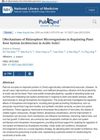Search
forProducts matching "system a"
Tracking 8 products like 13 Lonitab 10 mg, 123 Polaris minoxidil shampoo NR02, 125 Polaris Research NR08 7%, 127 Polaris Research NR11 12% Minoxidil Sulfate and 171 Hyphoral 200mg from by companies like AllDayChemist, Minoxidil Express and Inhouse Pharmacy. View all 8 products »
Sort by
Research
60-90 / 1000+ results
research Sex Differences in Steroid Levels and Steroidogenesis in the Nervous System: Physiopathological Role
Men and women have different levels and production of brain steroids, which may affect their risk for certain brain disorders.

research Hair Removal Using an Nd:YAG Laser System
Nd:YAG laser can reduce hair with multiple treatments, but permanent removal isn't guaranteed.

research Wnt1a Maintains Characteristics of Dermal Papilla Cells That Induce Mouse Hair Regeneration in a 3D Preculture System
Wnt1a helps keep cells that can grow hair effective for potential hair loss treatments.

research The Probable Destructive Mechanisms Behind COVID-19 on Male Reproductive System and Fertility
COVID-19 may harm male fertility and damage the reproductive system.

research Ovary And Uterus Related Adverse Events Associated With Statin Use: An Analysis Of The FDA Adverse Event Reporting System
Statins may be linked to reproductive organ conditions, and their risks should be monitored.
research An Update on the Roles of the Complement System in Autoimmune Diseases and the Therapeutic Possibilities of Anti-Complement Agents
Anti-complement agents could effectively treat autoimmune diseases with fewer side effects.

research Hair Transplantation in Women: A Practical New Classification System and Review of Technique
A new hair loss classification for women improves treatment, but careful patient selection is crucial for successful hair transplantation.

research Recent Updates of the CRISPR/Cas9 Genome Editing System: Novel Approaches to Regulate Its Spatiotemporal Control by Genetic and Physicochemical Strategies
CRISPR/Cas9 has improved precision and control but still faces clinical challenges.

research Minoxidil Delivered Via a Stem Cell Membrane Delivery Controlled Release System Promotes Hair Growth in C57BL/6J Mice
A new method using stem cell membranes to deliver Minoxidil improved hair growth in mice better than Minoxidil alone.

research KATP Channels in Zebrafish Cardiovascular System: A Model to Study Cantú Syndrome
Zebrafish with mutations similar to human Cantú Syndrome have heart cells with altered channel properties, making them a good model to study the condition.

research Polycystic Ovarian Syndrome: Proposal for an Evidence-Based Management Plan for an Electronic Patient Record System
The project improved provider knowledge about PCOS but didn't significantly change diagnosis and management practices.

research Drugs That Affect Autonomic Functions or the Extrapyramidal System
Some drugs can cause serious side effects like heart issues and nervous system problems, but certain drugs for Parkinson's and overactive bladder may be safer, though they still have some common side effects.

research Biology of the Wool Follicle: An Excursion into a Unique Tissue Interaction System Waiting to Be Rediscovered
The article concludes that the wool follicle is a valuable model for studying tissue interactions and has potential for genetic improvements in wool production.

research A Glutathione-Dependent Control of the Indole Butyric Acid Pathway Supports Arabidopsis Root System Adaptation to Phosphate Deprivation
Glutathione helps Arabidopsis roots adapt to low phosphate by regulating a specific growth pathway.

research Effectiveness of a Layer-by-Layer Microbubbles-Based Delivery System for Applying Minoxidil to Enhance Hair Growth
Minoxidil-coated microbubbles with sonication effectively enhance hair growth.
research Ex Vivo Organ Culture of Human Hair Follicles: A Model Epithelial–Neuroectodermal–Mesenchymal Interaction System
Hair follicle culture helps study cell interactions and effects of substances on tissue growth.

research Synthesis and Actions of 5α-Reduced Metabolites of Testosterone in the Nervous System
Testosterone and its metabolites affect brain functions and could help treat neurological disorders.

research Safety Concerns of Paternal Drug Exposure on Fertility, Pregnancy, and Offspring: An Analysis Based on the FDA Adverse Event Reporting System
Paternal drug exposure can harm fertility, pregnancy outcomes, and offspring health, with specific drugs linked to various reproductive issues.

research Drug-Induced Hair Loss: Analysis of the Food and Drug Administration’s Adverse Events Reporting System Database
Certain medications, including some immune drugs, contraceptives, and hair loss treatments, are often linked to hair loss.

research Possible Contributory and Protective Factors in Medication Associated Obstructive Sleep Apnea: Results from the US Food and Drug Administration Adverse Events Reporting System
Some drugs may increase the risk of obstructive sleep apnea, while others like certain biologics might decrease it.

research Safety Profile of Human Papilloma Virus Vaccines: An Analysis of the US Vaccine Adverse Event Reporting System from 2007 to 2017
HPV vaccines are generally safe but need further investigation for rare side effects.

research Avicequinone C Isolated from Avicennia Marina Exhibits 5α-Reductase Type 1 Inhibitory Activity Using an Androgenic Alopecia Relevant Cell-Based Assay System
Avicequinone C, a compound found in the Avicennia marina plant, can reduce hair loss by inhibiting a hormone linked to androgenic alopecia.

research Adaptive Minirhizotron for Pepper Roots Observation and Its Installation Based on Root System Architecture Traits
The new microrhizotron tool effectively observes and measures pepper plant roots non-destructively.

research Assessing Dutasteride-Associated Sexual Dysfunction Using the U.S. Food and Drug Administration Adverse Event Reporting System
Dutasteride is linked to a higher chance of sexual dysfunction, especially in younger males and the elderly.

research Mechanisms of Rhizosphere Microorganisms in Regulating Plant Root System Architecture in Acidic Soils
Microorganisms improve plant root growth in acidic soils, boosting productivity.
research Novel Method for Preparation of Autologous Leucocyte Rich Platelet Rich Plasma (L-PRP) Under Closed System and Assessment of Its Clinical Efficacy in Androgenic Alopecia: A Retrospective Cohort Study

research Long-Term Outcomes of Intravenous Corticosteroid Pulse Therapy for Rapidly Progressive Alopecia Areata: A Single-Center Retrospective Analysis of 106 Cases and Evaluation of a Scoring System for Extended Periods
Intravenous corticosteroid therapy is effective for long-term hair regrowth in alopecia areata, and a scoring system helps predict treatment success and relapse.

research Histological and Immunohistochemical Examination of the Effect of the Nonsteroidal Antiandrogen Flutamide on Some Organs of the Male Reproductive System in Albino Rats
Flutamide caused damage to male rat reproductive organs and may affect fertility.

research Safety Profile of Epidermal Growth Factor Receptor Tyrosine Kinase Inhibitors: A Disproportionality Analysis of FDA Adverse Event Reporting System
EGFR-TKIs can cause significant skin, nail, and organ side effects.